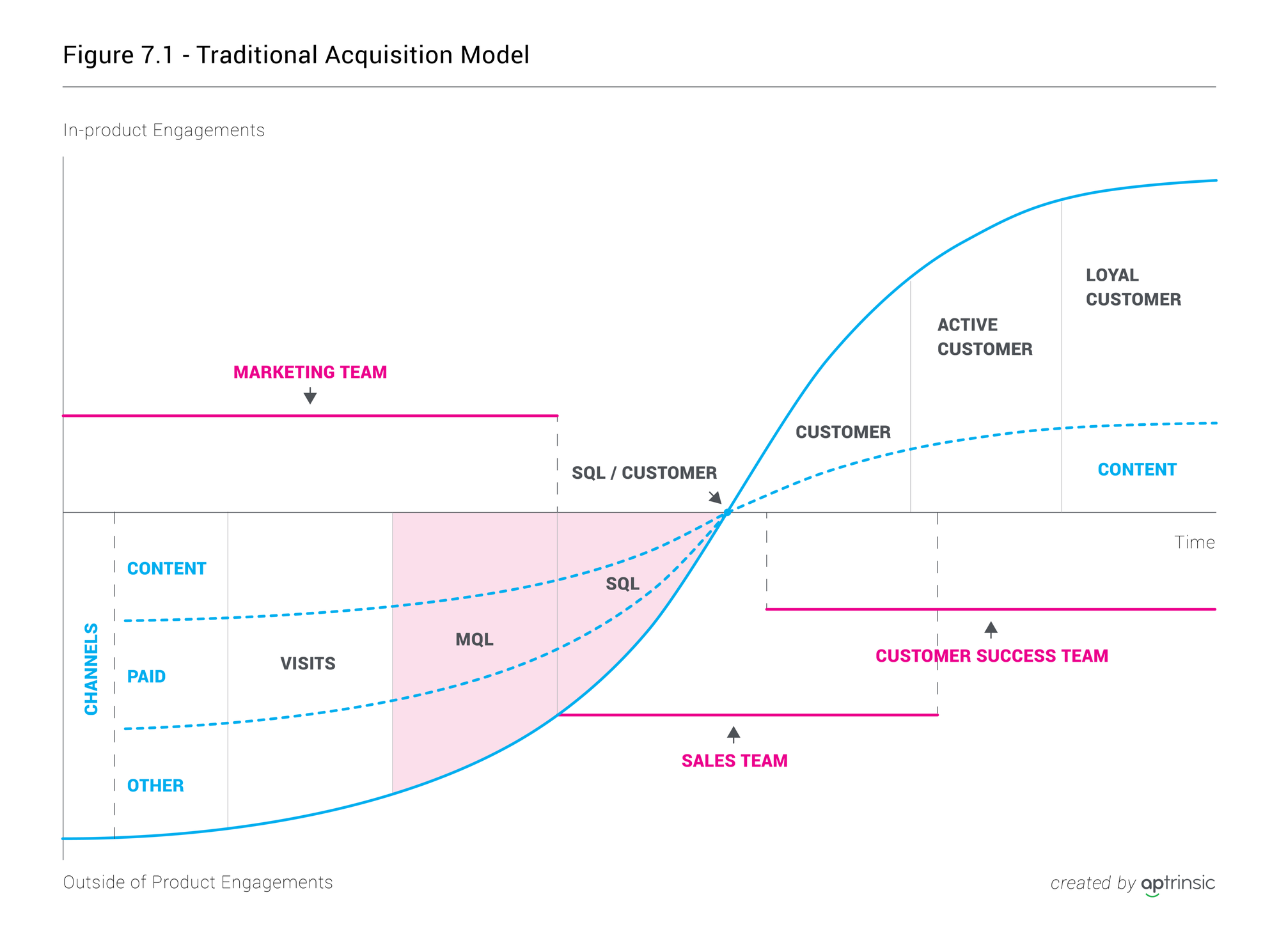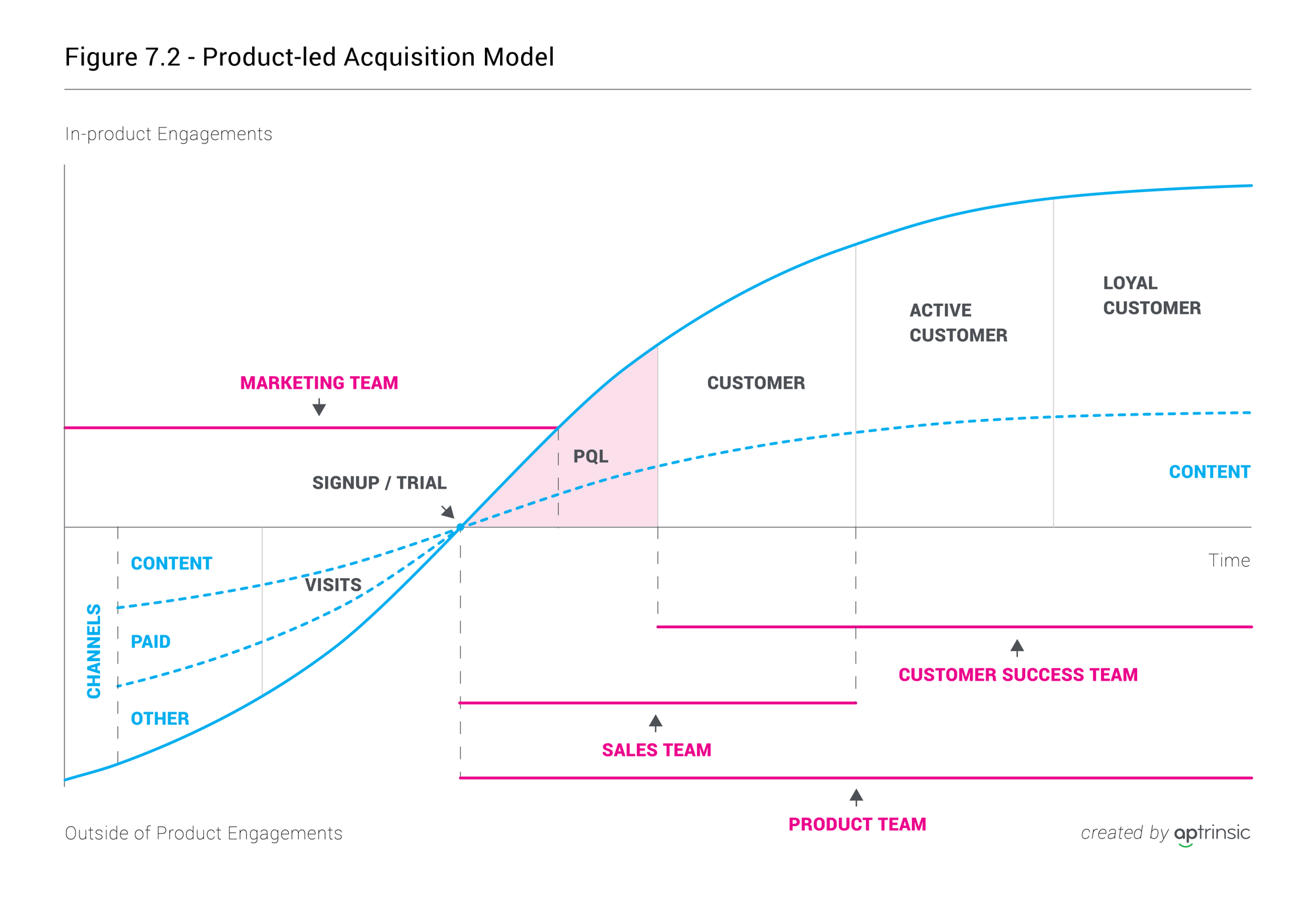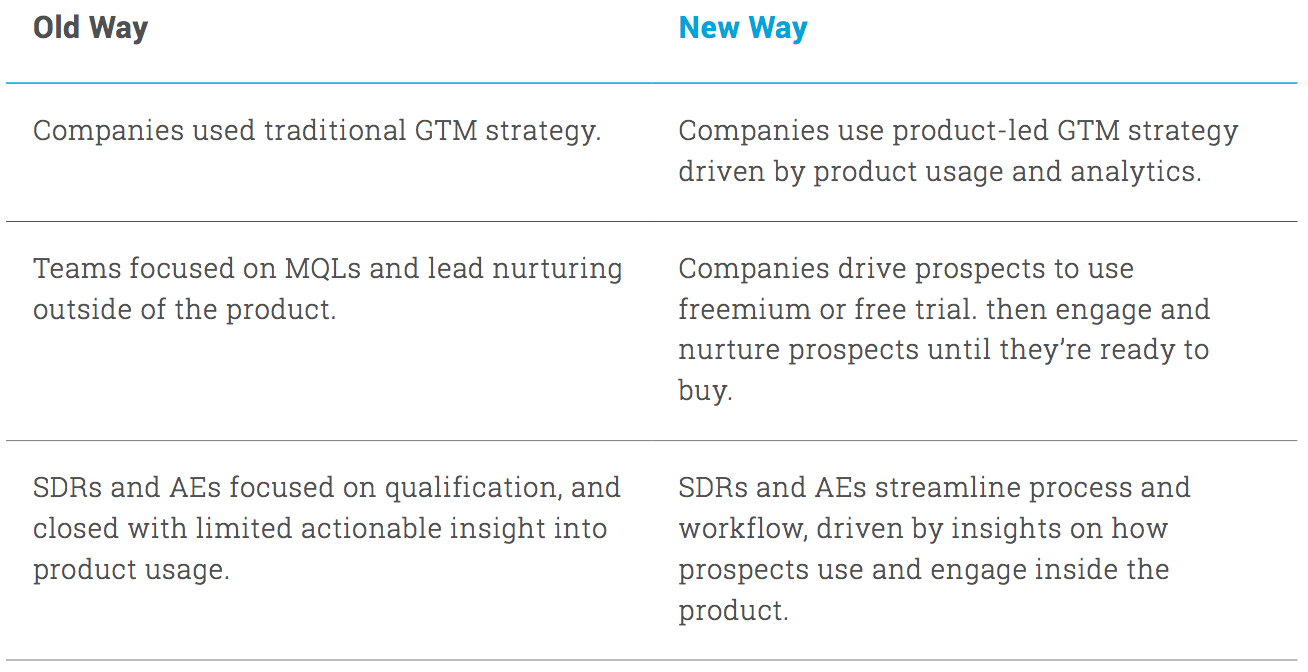Chapter 7: From a Traditional Go-To-Market to a Product-led Go-To-Market Strategy

Becoming a customer experience company is a challenging and continuous goal. You can — and should — always improve the customer experience; it’s not something you can achieve and put aside. Customer expectations change constantly, and switching cost are low, even in the enterprise markets. That brings us to the core element of the corporate strategy: GTM strategy.
A GTM strategy is similar to a military strategy. It takes into account the following elements:
- The environment and landscape of the battle (i.e., market conditions) and competitive positioning
- The target or enemy (i.e., target customer)
- Weapon of choice (i.e., product offering and pricing)
- How the operation will be carried out (i.e., customer acquisition process and channels)
Combined, these outline a customer acquisition process, which explains how the company will attract and convert buyers. Here is the definition of a traditional GTM strategy:
Go-to-Market (GTM) strategy is an action plan that describes repeatable and scalable processes for how a company acquires, retains, and grows customers.
So, what impact does GTM strategy have on the quality of customer experience, and why is it crucial for companies to change their GTM strategy if they want to improve customer experience?
As we highlighted, customer experience requires organizations to go beyond demographics and firmographic data to understand customer needs, values, and expectations. These insights will help your organization personalize its product offering, pricing, and message to improve the customer experience; but it will also help you understand what journeys, channels, and processes best match customer expectations. Every organization serious about focusing on customer experience has to evaluate and optimize its GTM strategy to align with a vision of delivering a better customer experience.
It is worth noting that to be successful, a GTM strategy must be repeatable and scalable.
- Repeatable means that the organization can expect very similar results when executing against a particular GTM playbook.
- Scalable means the company can hire and train new employees using the GTM playbook, and see proportional revenue growth in acquiring customers.
Traditionally, a GTM strategy highlights channels as the fourth essential element, but in the last two decades, digital transformation drove an explosion of new channels for organizations to reach prospective customers. Seeing that a prospective customer can switch from one channel to another in a matter of seconds, channels themselves became somewhat less important. What matters more is the overall customer acquisition process, which is intertwined with every aspect of a GTM strategy.
In other words, the customer acquisition process is changing because of changing customer expectations and the increasing number of channels through which prospective customers can be reached. Enterprise buyers expect to try and evaluate software in an easy, frictionless way. As a result, a new approach to customer acquisition has emerged where the product itself becomes a channel for acquiring, retaining, and growing customers. This approach fundamentally changes the traditional GTM strategy by elevating product as one of the primary channels. This new strategy is referred to as a product-led GTM strategy. The name suggests the importance of product as a tool and channel to attract, retain, and grow customers.
Product-led go-to-market strategy is an action plan that describes repeatable and scalable processes for how a company acquires, retains, and grows customers, driven by in-product customer behavior, feedback, product usage, and analytics.
In a product-led GTM strategy, the product becomes a crucial and irreplaceable part of every step of how your company prepares to reach and engage prospective customers. In fact, OpenView, a venture capital firm, says your product is a key part of your marketing. One of the major benefits of this approach is receiving in-product user behavioral data that can be then used to change or adapt the whole GTM process. How prospective customers interact with your product early in the buying success could help your company make better decisions about what features to build next. You could even adjust marketing messages based on in-product behaviors to highlight values and features that correlate with a higher probability of a prospect becoming a customer.
A product-led GTM enables companies to focus more on effective product growth strategies, and incorporate real-time, in-product customer behavioral data to create meaningful engagement across multiple channels and devices.
- Is there anything more relevant and valuable (from a GTM perspective) for a company to improve the customer experience than data showing how prospective customers engage with its product?
- How valuable would it be for you and your extended team to fully understand how and why a single customer (or segment of customers) uses your product, given their unique customer attributes and journeys?
This is a critical point for companies to understand: your product becomes a channel and owned media. We aren’t the only ones to note the significance of this shift in the SaaS market:/ Natalie Diggins, former Entrepreneur in Residence at Openview VP and current VP of Strategy at NeuStar, wrote an article explaining how some companies use their product as a primary growth channel.
- How can an organization build an effective GTM strategy without understanding customer behavior, experiences, and journeys within the product?
We hope the answer is clear by now, but let’s discuss one other main difference between a traditional and product-led GTM: in the latter, companies focus on driving prospects to try their product instead of driving them to lead forms, and then bombarding them with a bunch of nurturing e-mails. This strategy goes nowhere without prospects filling out lead forms, and one study found that lead forms are filled out on average only 11 percent of the time.
7.1 Are Marketing-Qualified Leads (MQLs) Dead?
Gating content as a way to generate leads has become increasingly less effective. Aside from the fact that prospects do not want to share contact information and would rather evaluate a product via a trial or freemium option, lead forms create inefficiencies in the customer acquisition process. A large portion of leads are prospects that will never be your customers: people who do research on the subject, students, and prospects that don’t fit your ideal customer profile.
This fills your database with bad lead data, which can be a big problem. Bad data clutters your marketing automation and CRM solutions with duplicates and bogus data. Depending on how you slice and dice SaaS industry data, the average conversion rate from visitor to lead is around 5 to 15 percent. While the research findings vary, the conversion rate from lead to a won deal is anywhere from 1 to 10 percent. Marketing teams spend a majority of their resources and efforts nurturing leads that are never going to convert. If you still use lead forms and MQLs to generate leads, ask yourself: What percentage of your lead data is garbage (bogus data provided by those filling out your lead forms)? In other words, how much of it is inaccurate data, or from people who aren’t truly prospective customers? What percentage of your MQLs fall outside of your ideal customer profile (e.g., two-people startups, students, or maybe even competitors)?
A poor lead conversion rate is partly due to a very low buying intent among prospects that fill out a lead form. On the other hand, signing up for a free trial or freemium product shows a higher interest in your product. Also, a free trial entices prospects to use accurate credentials, since the confirmation process is often a required step for getting meaningful access to the product.
What about lead nurturing and lead scoring? Companies such as Marketo and Hubspot, which popularized a marketing-led customer acquisition approach, also introduced lead scoring and nurturing techniques to help marketers improve conversion rates and bring some kind of prioritization to the process. Lead nurturing based only on contact information (i.e., demographic data) and marketing activities (e.g., opened e-mail, visited web page) can’t be very effective. Nurturing and scoring techniques become arbitrary marketing, automating and personalizing interactions with prospects based on data that is only minimally correlated with buying intent. Plus, most organizations cannot personalize e-mail nurturing campaigns, because they lack customer in-product behavioral data.
As a result, companies experience a much-talked-about marketing-sales gap, where marketers pass prospects to sales that aren’t ready to buy, and sales complains about lead quality. As an industry, we have to admit that marketing-sales misalignment is due to ineffective lead generation strategies that emphasize quantity of leads over quality. What has made things even more convoluted is that MQLs are not qualified for pipeline forecasting. As a result, sales teams spend time working and further qualifying these leads as SQLs. This not only makes things inefficient, it increases the CAC.
Many teams that made the shift to a product-led GTM strategy have abandoned the traditional approach to customer acquisition and MQLs along with them. If you want to explore this further, read why Tom Wentworth, CMO of RapidMiner, is killing MQLs.
Some of the fastest-growing companies in recent years do not put any lead generation forms on their websites, and instead invite prospects to try their products. This list includes Zoom.us, Asana, inVision, and Slack — and it’s growing. Prospects search for and find product reviews and other valuable information; after all, they don’t want to hear marketing messages that use too much jargon, hyperbole, superlatives, or buzzwords. One quick point on ungated content: Just think about how much marketing attention you are losing by gating your content. When you don’t gate your content, readers can share it and contribute to spreading your message across target markets even if they aren’t part of your ideal customer profile. But people rarely link or refer to gated content.
Let’s be clear: A content strategy around thought leadership is still important for organizations to drive awareness and demand. It has become one of the most efficient ways for companies to engage with prospects, by educating target audiences (prospects and customers) on industry trends, new strategies, and tactics. We believe a sound content strategy is key to growth, but your assets should not hide behind a form. Even more important, your content should be delivered to prospects and customers in a contextual way to move them through the lifecycle.
In an article, Tae Hea Nahm, managing director at Storm Ventures, explains the importance of thought leadership and content strategy for startups. That said, the end goal and metrics will shift from generating marketing leads to driving signups and product-qualified leads (PQLs), in which prospects try the product first.
7.2 What Are Product-Qualified Leads (PQLs)?
One of the earliest mentions of the PQL concept is in an article by Tomasz Tunguz from early 2013, “The Product-Qualified Lead (PQL).” It describes a natural progression from MQLs to PQLs. However, the PQL only makes sense as part of a larger, product-led GTM strategy.
We believe PQLs are a better way for cross-functional teams to create sales-ready accounts and more active customers. PQLs provide a more accurate method of tracking customer journeys. This is a key metric for any company that’s transitioning to a product-led GTM strategy. As a reminder, here’s a definition:
Product-qualified lead (PQL) is a prospect that signed up and demonstrated buying intent based on product interest, usage, and behavioral data.
Instead of driving prospects to lead forms, a product-led GTM strategy drives prospects to sign up for a product or free trial. From that moment on, marketing teams can analyze how prospects use the product to nurture or re-engage them until they are ready to buy.
A product-led GTM strategy streamlines the customer acquisition process for SaaS organizations by focusing on one entry point for prospects. When prospective customers sign up for a freemium or free trial, they show a higher buying intent. They also afford the company’s teams the opportunity to analyze how prospects interact with the product in their natural environment.
Furthermore, marketing teams using behavioral data can re-engage customers that have left the product and haven’t returned. Product-led GTM makes it possible for companies to personalize the onboarding experience, and collect insight into what features drive the most value. It also helps pinpoint steps in customer journeys that cause a negative customer experience and result in product abandonment.
Today’s sales process rarely incorporates an efficient way for SDRs and AEs to apply product usage data to prioritize their workflow and outreach to prospects. However, sales processes can change in this way when the organization focuses on PQLs instead of MQLs/SQLs. Sales teams can use behavioral data to better prioritize and forecast (by Sales Hacker). Product leaders can get early feedback on what features drive product growth, what in-product journeys are more effective, and what onboarding process results in higher product adoption. Simply put, this approach works for both the company and prospects by enabling a frictionless buying experience.
In the article “Why Product-Qualified Leads are the Answer to a Failing Freemium Model”, Christopher ODonnell explains why PQLs are critical for companies with a freemium business model. However, we believe that product-led GTM strategy and PQLs not only work for the freemium model, but are also essential for almost every SaaS company. Prospects expect to see the product early in the buying process. A product-led strategy brings to life the “don’t tell me, let me try!” idea, while PQLs track and measure buying intent more effectively.
To be clear, prospect nurturing and engagement can happen inside the product via in-product messaging, or through other channels such as e-mail, mobile notifications, etc. Customer in-product behavior not only influences how a company nurtures and re-engages customers to come back into the product, but also triggers ideas for content strategy and marketing. Customer behavior is a strong signal of what your target audience cares about, and provides insight into how best to engage with them further.
Let’s dive into how a product-led GTM changes the customer acquisition process.
7.3 The Traditional Approach to Customer Acquisition Process
As stated earlier, companies that use the traditional approach to customer acquisition (as shown in Figure 7.1) make it a habit to analyze this process from the company perspective.
What is important to highlight is that a large portion of the traditional customer acquisition process happens outside of the product. This prevents companies from collecting critical behavioral data that can help improve nurturing and customer interaction.

Marketing teams are in charge of the customer lifecycle up until prospects become MQLs. SDRs are responsible for quality marketing leads and generating sales-ready (or sales-qualified) leads (SQLs). AEs focus on converting SQLs into won customers, and then pass them to the customer success team, whose task is to onboard newly acquired customers and ensure they become active and loyal customers. Let’s see how a product-led approach changes this process.
7.4 A Product-led Approach to the Customer Acquisition Process
A product-led GTM strategy makes your product an essential part of the acquisition process. Figure 7.2 shows how this strategy significantly reduces the time it takes for prospects to access the product. When compared to the traditional customer acquisition process, companies focus less on the customer lifecycle part outside of product engagement. The customer lifecycle shifts more into the elevated axis area, where product behavior becomes essential in guiding customers through the lifecycle.
As explained earlier, product usage data can be leveraged by every team to efficiently move prospects through the customer acquisition process. Furthermore, it is easier for sales, marketing, product, and customer success to agree on what defines a PQL. That’s because this metric calls upon more concrete data, compared with the way that MQLs/SQLs are defined.

Dropbox is an example of a company that drives prospects directly into the product and nurtures them until they are ready to buy. When prospects approach a certain percent of the storage available on their freemium product, Dropbox sends a notification to the desktop app and over e-mail. It’s worth noting that Dropbox has reached a $1B revenue run rate faster than any other company.
As shown, product-led GTM strategies provide several benefits. In a nutshell, product, marketing, sales, and success teams are more aligned to deliver personalized customer experiences that are more engaging and result in higher conversions, loyalty, and revenue growth. By doing this right, companies reduce their CAC, accelerate trial-to-conversions, and increase CLV. In Part III, we dive deep into the essential elements of a product-led GTM strategy.

To deliver great customer experiences today, companies must understand the customer lifecycle, unify customer data, and track their customers’ personal journey through their products. This is not possible when following a traditional GTM strategy. However, it is possible when companies embrace a product-led GTM strategy that centers on providing access to the product earlier in the buying cycle via free trials or freemiums.
Such an approach also enables organizations to become truly customer-experience- focused, and provides a clear path for cross-functional teams to align around the buyer’s journey and full customer lifecycle. Moreover, it provides the type of product usage insights that are critical for delivering personalized experiences that advance prospects and customers from one stage to the next. These same insights can guide product teams to understand and determine the most valued features and ways to further optimize their products.
Simply put, your product should be at the center of your GTM strategy — your action plan for how your company acquires, retains, and grows customers. To succeed with this approach, every department must align around relevant goals and metrics, and you must equip these teams with the right tools and data.
